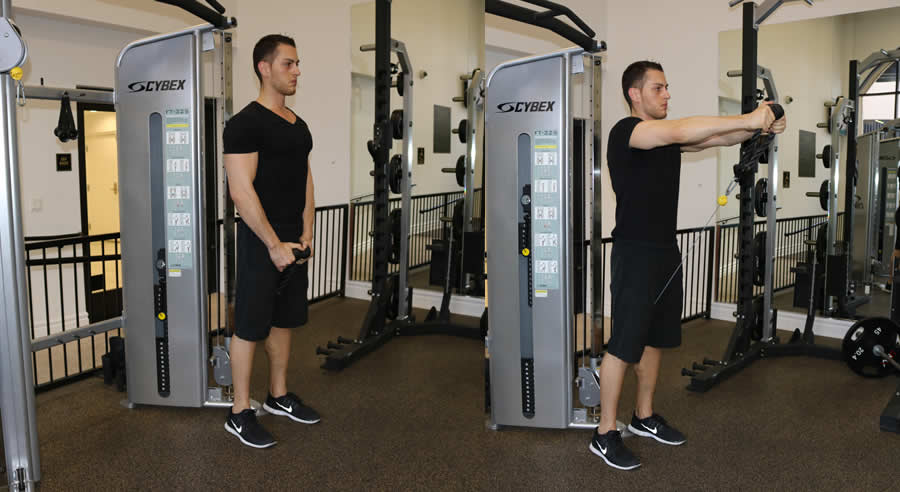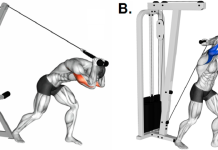Cable Front Raise: A Comprehensive Guide to Shoulder Sculpting
When it comes to sculpting well-defined shoulders, the cable front raise stands out as a potent exercise that targets the anterior deltoids, enhancing both muscle definition and overall shoulder strength. In this comprehensive guide, we’ll delve into the intricacies of the cable front raise, from its benefits and proper execution to variations and expert tips. Whether you’re a fitness enthusiast or a beginner looking to refine your shoulder workout routine, this guide has you covered.
Benefits of Cable Front Raise
The benefits of the cable front raise extend beyond aesthetics, offering functional strength and improved shoulder stability. By performing this exercise, you’re engaging the anterior deltoids, the front portion of the shoulder muscles. This engagement leads to several key advantages:
1. Targeted Muscle Engagement: The cable front raise hones in on the anterior deltoids, promoting balanced shoulder development. Well-developed deltoids contribute to the coveted V-taper physique.
2. Enhanced Range of Motion: The controlled movement provided by the cable machine allows for a full range of motion. This contributes to optimal muscle activation and overall shoulder flexibility.
3. Improved Shoulder Stability: Strengthening the anterior deltoids enhances shoulder stability, reducing the risk of injuries during daily activities and other workouts.
4. Muscle Isolation: The cable front raise isolates the anterior deltoids, minimizing the involvement of other muscle groups. This isolation ensures that the target muscles are effectively engaged without unnecessary strain on other areas.
5. Progressive Overload: As you gradually increase the weight and resistance, you encourage progressive overload, a fundamental principle of muscle growth. This leads to continuous shoulder development over time.
6. Functional Strength: Strong anterior deltoids play a vital role in various upper body movements, such as pushing and lifting. Incorporating cable front raises into your routine can enhance your overall functional strength.
7. Versatility: The cable front raise can be integrated into various workout routines, such as upper body, shoulder-focused, or full-body workouts. Its versatility makes it a valuable addition to different fitness regimens.
To unlock these benefits, it’s crucial to perform the cable front raise with proper form and technique. In the next section, we’ll guide you through the step-by-step execution to ensure you maximize its potential.
Proper Form and Technique
Executing the cable front raise with correct form is essential to reap its rewards while minimizing the risk of injury. Follow these steps to perform the exercise effectively:
1. Equipment Setup: Begin by attaching a D-handle to the low pulley of the cable machine. Adjust the weight stack to a manageable level.
2. Starting Position: Stand facing the cable machine with your feet shoulder-width apart. Hold the D-handle with an overhand grip using one hand. Your palm should be facing your body.
3. Movement: Keep a slight bend in your elbow and maintain a straight back throughout the exercise. Slowly lift the handle in front of you, ensuring your arm is parallel to the floor and fully extended.
4. Peak Contraction: At the top of the movement, pause briefly to feel the contraction in your anterior deltoids. Focus on maintaining tension in the deltoids rather than using momentum.
5. Controlled Descent: Lower the handle back to the starting position in a controlled manner. Avoid letting the weight stack touch down between repetitions to keep tension on the muscles.
6. Breathing: Inhale as you lower the handle and exhale as you lift it.
7. Range of Motion: Avoid raising the handle higher than shoulder level to prevent excessive strain on the shoulder joints.
Start with a weight that allows you to perform 3 sets of 10-12 controlled reps. Focus on the mind-muscle connection, feeling the anterior deltoids working throughout the movement. As you become more comfortable, gradually increase the weight to continue challenging your muscles.
Muscles Targeted
The cable front raise primarily targets the anterior deltoids, the muscles located at the front of the shoulder. These muscles play a crucial role in various upper body movements, including pushing, lifting, and overhead actions. However, during the cable front raise, other muscles also come into play to provide stability and support:
- Anterior Deltoids: As the primary focus of the exercise, the anterior deltoids are responsible for raising the arm in front of the body. Strengthening these muscles contributes to shoulder definition and an overall balanced physique.
- Lateral Deltoids: While not the main target, the lateral deltoids (side shoulder muscles) are engaged to stabilize the arm during the movement.
- Upper Trapezius: The upper trapezius, located along the upper back and neck, assists in maintaining shoulder and neck stability as the arm is raised.
- Serratus Anterior: The serratus anterior muscles, situated between the ribcage and shoulder blades, help stabilize the scapula during the movement.
- Core Muscles: Engaging your core muscles helps maintain proper posture and stability throughout the exercise.
Understanding the muscles involved in the cable front raise enables you to appreciate its comprehensive impact on shoulder development. By targeting these specific muscles, you can create a well-rounded shoulder routine and achieve a balanced and sculpted upper body.
Variations and Modifications
To keep your shoulder workouts engaging and prevent plateaus, incorporating variations and modifications of the cable front raise is key. These variations target different aspects of shoulder development and can be tailored to your fitness level and goals:
1. Unilateral Cable Front Raise:
- Perform the cable front raise with one arm at a time. This variation enhances focus and challenges shoulder stability.
- It’s particularly effective for addressing any muscle imbalances between your left and right shoulders.
2. Angled Cable Front Raise:
- Change the angle of the cable by positioning it slightly to the side. This engages the deltoids from a different angle, stimulating new muscle fibers.
- Experiment with various angles to find the position that feels most effective for your shoulder development.
3. Cable Lateral Raise Combo:
- Combine the cable front raise with a cable lateral raise in a superset fashion. This targets both the front and side deltoids, providing a well-rounded shoulder workout.
- Perform the cable front raise immediately followed by the lateral raise without rest between sets.
4. Cable Front Raise with Resistance Bands:
- If you don’t have access to a cable machine, you can perform a similar movement with resistance bands.
- Secure the bands at a low anchor point and mimic the cable front raise movement with the bands in your hands.
5. Cable Front Raise with Twist:
- As you raise the handle, rotate your hand slightly to the side. This engages the front deltoids in a unique way and adds a rotational element to the movement.
6. Drop Sets:
- Incorporate drop sets by decreasing the weight after each set while maintaining the same number of reps. This intensifies the workout and encourages muscle growth.
Remember to prioritize proper form and controlled movements in each variation. Begin with a weight that allows you to perform the desired number of repetitions with good technique. As you progress, gradually increase the resistance to continue challenging your muscles.
Incorporating Cable Front Raises into Your Routine
To maximize the benefits of the cable front raise and ensure well-rounded shoulder development, strategically integrating it into your workout routine is essential. Whether you’re aiming for muscle definition, strength, or overall shoulder improvement, here’s how to effectively include cable front raises:
1. Shoulder-Focused Workouts:
- Design dedicated shoulder workout sessions where cable front raises take center stage.
- Begin your routine with compound movements like overhead presses and lateral raises before moving on to cable front raises for targeted isolation.
2. Upper Body Split Routine:
- Incorporate cable front raises into your upper body split routine.
- Pair them with exercises that target other muscle groups, such as chest or back, to ensure balanced development.
3. Supersets and Giant Sets:
- Combine cable front raises with exercises for other muscle groups to save time and increase workout intensity.
- Superset cable front raises with tricep exercises or giant set them with lateral raises and rear delt flyes for a comprehensive shoulder workout.
4. Progressive Overload:
- Apply the principle of progressive overload by gradually increasing the weight you use for cable front raises.
- Aim to challenge yourself with heavier weights while maintaining proper form and control.
5. Mind-Muscle Connection:
- Focus on establishing a strong mind-muscle connection during the exercise.
- Visualize your anterior deltoids working as you lift the handle and contract them at the top of the movement.
6. Frequency and Recovery:
- Include cable front raises in your routine 1-2 times per week for optimal results.
- Allow adequate recovery time between sessions to avoid overtraining.
7. Tracking Progress:
- Keep a workout journal to track the weights, sets, and reps you perform for cable front raises.
- Monitoring your progress helps you stay accountable and adjust your routine as needed.
Common Mistakes to Avoid
While the cable front raise is a highly effective exercise for shoulder development, certain mistakes can hinder your progress and potentially lead to discomfort or injury. By being aware of these common pitfalls, you can ensure you’re performing the exercise optimally:
1. Using Excessive Weight:
- One of the most common mistakes is selecting a weight that’s too heavy.
- Using excessive weight can compromise your form and lead to unnecessary strain on your shoulders and joints.
2. Swinging or Momentum:
- Avoid using momentum to lift the weight. Instead, focus on controlled and deliberate movements.
- Swinging the weight not only reduces the effectiveness of the exercise but also places stress on other muscle groups.
3. Incorrect Body Positioning:
- Maintain proper posture throughout the movement. Avoid arching your back or leaning backward.
- Keep your core engaged and stand tall to prevent strain on your lower back.
4. Raising Too High:
- While it’s important to achieve a full range of motion, avoid raising the handle higher than shoulder level.
- Raising too high can lead to unnecessary stress on the shoulder joints.
5. Neglecting the Eccentric Phase:
- The eccentric (lowering) phase of the movement is just as important as the concentric (lifting) phase.
- Lower the handle in a controlled manner to maintain tension on the muscles throughout the entire exercise.
6. Rushing Through Repetitions:
- Focus on performing each repetition with a deliberate pace.
- Avoid rushing through the exercise, as this can lead to improper form and reduced muscle engagement.
7. Ignoring Muscle Engagement:
- Concentrate on engaging the anterior deltoids throughout the movement.
- Visualize the muscles working as you lift the handle and contract at the top of the movement.
Safety Precautions
Prioritizing safety during your workouts is paramount to prevent injuries and promote long-term progress. As you incorporate cable front raises into your routine, consider the following safety precautions:
1. Warm-Up Adequately:
- Begin your workout with a thorough warm-up that includes dynamic stretches and light cardio.
- A warmed-up body is more prepared for the demands of the cable front raise exercise.
2. Choose Appropriate Weight:
- Select a weight that challenges you without compromising your form.
- Gradually increase the weight as you become more comfortable with the movement.
3. Maintain Proper Posture:
- Keep your back straight and shoulders down throughout the exercise.
- Avoid hunching or arching your back, which can strain your spine and shoulders.
4. Focus on Form:
- Emphasize proper form and technique over lifting heavy weights.
- Engage your anterior deltoids and avoid using momentum to lift the handle.
5. Breathe Consistently:
- Inhale as you lower the handle and exhale as you lift it.
- Consistent breathing helps stabilize your core and enhances overall control.
6. Listen to Your Body:
- Pay attention to any discomfort or pain during the exercise.
- If you experience unusual pain, stop the exercise and consult a fitness professional or healthcare provider.
7. Gradual Progression:
- Progressively increase the weight and intensity of the exercise over time.
- This approach minimizes the risk of overuse injuries and ensures gradual muscle adaptation.
8. Incorporate Rest Days:
- Allow sufficient time for muscle recovery by incorporating rest days into your routine.
- Overtraining can lead to injuries and hinder progress.
9. Hydrate and Fuel:
- Stay hydrated before, during, and after your workout.
- Proper hydration and nutrition contribute to optimal muscle function and overall performance.
10. Consult a Professional: – If you’re new to exercise or have any pre-existing medical conditions, consult a fitness professional or healthcare provider before beginning a new workout regimen.
By following these safety precautions, you can enjoy the benefits of the cable front raise while minimizing the risk of injuries. Remember that your safety and well-being are paramount, and any discomfort or unusual sensations should be addressed promptly.

Sculpting Strong Shoulders with Cable Front Raises
As you conclude your journey through this comprehensive guide, you’ve gained valuable insights into the world of cable front raises and their role in achieving sculpted and strong shoulders. The cable front raise exercise offers numerous benefits, from targeted muscle engagement and enhanced range of motion to improved shoulder stability and functional strength.
By mastering the proper form and technique, you can maximize the effectiveness of the cable front raise. Remember to focus on engaging the anterior deltoids, avoiding common mistakes, and progressing gradually to challenge your muscles over time.
The versatility of the cable front raise allows you to tailor your workouts to your goals and preferences. Whether you’re aiming for muscle definition, strength, or overall shoulder improvement, the exercise can be seamlessly integrated into various workout routines.
As you embark on your fitness journey, keep in mind the safety precautions outlined in this guide. Prioritize proper warm-ups, choose appropriate weights, and listen to your body to prevent injuries and ensure a smooth training experience.
Ultimately, the cable front raise serves as a cornerstone in your quest for well-defined shoulders. Through consistency, dedication, and a balanced approach to your fitness routine, you can achieve the sculpted upper body you’ve been working towards.
Remember that achieving your goals takes time, patience, and perseverance. Embrace the process, celebrate your progress, and continue to challenge yourself as you sculpt strong and impressive shoulders with the cable front raise exercise.
Thank you for embarking on this journey with us. Here’s to your success and continued growth on your fitness path!




